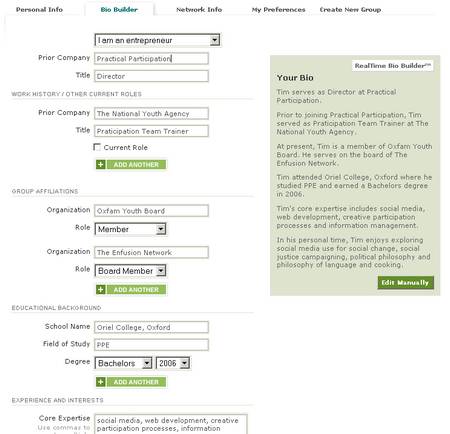One of the posts in the recent Knowledge Jam on technologies for collaboration for social change suggested the CollectiveX platform as a space for creating online communities or practise.
I've just been exploring it for a client, and:
a) It looks like a really easy to set up platform with good support for RSS feed agregation, online discussions, file sharing, networking and member profiles. (If you're looking to be up-and-running inside a couple of hours with a community website for a small team – and you're not anticipating needing to add any particular advanced features in the future – then it seems well worth a look.)
and
b) It has one of the most fantastic features I've ever come across in an online community system. It writes my biography for me.

No more copy and paste from a standard bio that doesn't quite fit the tone of the site. No more trying to work out what to write in the large white 'about me' form field. Nope. I simply fill in a few fields about where I work, my core skills and interests… and bingo… one biography:
Tim serves as Director at Practical Participation.
Prior to joining Practical Participation, Tim served as Praticipation Team Trainer at The National Youth Agency.
At present, Tim is a member of Oxfam Youth Board. He serves on the board of The Enfusion Network.
Tim attended Oriel College, Oxford where he studied PPE and earned a Bachelors degree in 2006.
Tim's core expertise includes social media, web development, creative participation processes and information management.
In his personal time, Tim enjoys exploring social media use for social change, social justice campaigning, political philosophy and philosophy of language and cooking.
Hmm, think I might use this one on the blog…